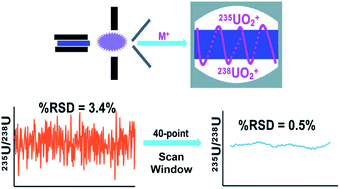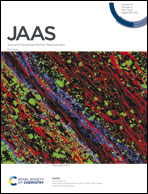Improved uranium isotopic ratio determinations for the liquid sampling-atmospheric pressure glow discharge orbitrap mass spectrometer by use of moving average processing
Abstract
The liquid sampling-atmospheric pressure glow discharge (LS-APGD) is a versatile combined atomic and molecular (CAM) ionization source capable of ionizing elemental species, small polar compounds, low-polarity polycyclic aromatic hydrocarbons, and proteins. While the LS-APGD has been proven capable of determining the 235U/238U isotope ratio in enriched and natural uranium, recent efforts have strived to reduce the analysis time of individual measurements by employing higher-order data processing techniques, specifically, moving average methods. The use of a moving average (of data windows of various widths) improves the precision of the ratio measurements and reduces the number of scans needed to be collected to generate high-precision results. Additionally, use of the moving average minimizes the quantity of sample that needs to be analyzed while reducing the measurement time. These reductions have allowed isotope ratio (IR) determinations to be made using injections instead of direct infusion of the analyte. For example, employing a 40-point window width in the moving average to direct infusion data reduced the percent relative standard deviation (% RSD) of the 235U/238U values from 3.4% to 0.5%. For the injection of a 100 μL aliquot, the % RSD was reduced from 5.3% to 0.7%.

- This article is part of the themed collection: Community Leaders: Ramon Barnes


 Please wait while we load your content...
Please wait while we load your content...
